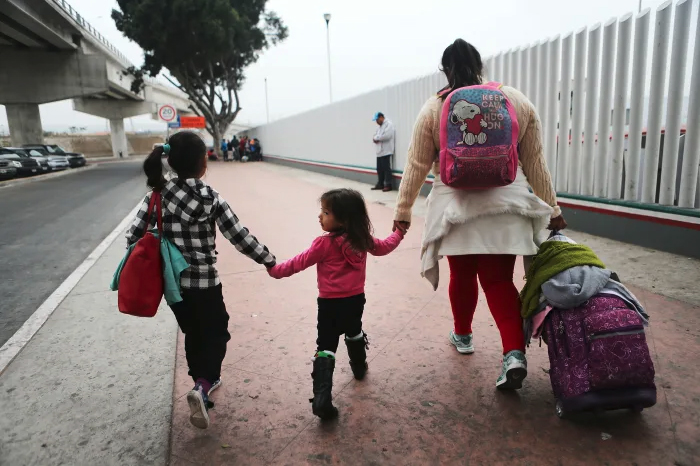Despite Trump’s era policies being reversed, the likelihood of finding protection in the US is lower than ever
by Jenny Manríquez
Ethnic Media Services
After escaping the abuse and persecution from an active gang member from La Mara 18 in her native El Salvador, Milagro won her asylum case in the United States last August on domestic violence grounds.
She crossed the Mexican border in 2015, escaping from her kidnapper, who repeatedly raped her and threatened to murder her family. “My life was always in danger, I filed a complaint (in El Salvador) but my case was not solved and they did not help me at all,” said Milagro during an Ethnic Media Services briefing that focused on the way domestic violence victims struggle to find protection in the United States.
The woman, who agreed that her story could be published without using her last name, was about to get married when the gang member became obsessed with her and began to harass her over the phone, saying that he would have her “whether you like it or not” .
Since then, the raping began repeatedly, including threats with weapons, blows to the entire body and burnings with an iron. Her rapist even fractured her hands.
“The last time he beat me for four hours, he wanted to kill me, he told me that he was going to cut me into pieces and leave half of my body at my grandmother’s, and half at my uncle’s.” After Milagro escaped, the gang member kept looking for her in every nook and cranny of her city, so she decided to leave the country.
“When I crossed (the border) I told them (immigration officials) that my life was in danger, that if I returned he would kill me, wherever I was he would look for me… Thanks to God and the lawyer I got it (the asylum), but it was a long struggle.”
Almost five years after presenting her case (December 2016), she received her status and with it, the path to legal residence in the country. She is the mother of a little girl, now pregnant with a boy, and although she is in a stable and healthy relationship, “there is still that trauma that one cannot remove. It is like a big burn and a scar remains, even if you want to erase it, you can’t.”
The U.S Refugee Act of 1980 allows people to apply for refugee status abroad or asylum status at the border or within the United States. They are eligible if they demonstrate what is known as “a well-founded fear,” meaning that the persecution is due to their race, religion, nationality, political opinion, or membership in a particular social group.
Marta Victoria Canossa, an immigration attorney for the Los Angeles-based firm Ortega, Canossa y Asociados, who is handling the Milagro case, stressed that it is important that those escaping domestic violence in their countries of origin present their case within the first year they enter the United States.
“It is very difficult for an abused woman to go to an American embassy and request asylum, even for those who have family already here in the United States or have an application pending,” she said. “This lack of resources at the embassy level forces women to present their claims at the Mexican border. If they don’t do it as soon as they cross, they have a year to do it.”
To support these claims, defenders have found useful reports issued every year by the State Department on the situation of the countries in Latin America, which highlight the problems faced by these abused women in finding help in their own governments.
VAWA and U Visa
For women who suffer domestic violence within the United States, they have two options: they can present their case through the Violence Against Women Act (VAWA) in force since 1984, or apply for a U visa.
“VAWA is available to people married to legal permanent residents or citizens of the United States,” Canossa said. Under this law, which also protects men, applicants are not required to submit a police report: their own declaration or a witness one, along with proof such as images and text messages, are sufficient. “Approval is taking from 21 to 28 months, but they can also apply for work permits while they wait,” Canossa said.
The application under VAWA must be made while the person is still married to the abuser or within two years of their divorce.
As for U VIsa, this relief is available to women who are victims of people who have no documents or were not married to US citizens. However, it requires a police report which “is sometimes challenging when the person is in a jurisdiction where the police don’t want to cooperate.”
The other difficulty is that the wait for the U visa exceeds 5 years, a time in which the person does not receive a work permit.
Sessions vs. Garland
The road to reaching these protections has been long. Beginning in the 1990s, guidelines were adopted on how women’s claims for domestic violence could fit into the Refugee Convention.
“In 2014 the Justice Department’s Board of Immigration Appeals issued a decision that explicitly recognized domestic violence as a basis for asylum,” Bookey said. “But in 2018, Trump’s Attorney General, Jeff Sessions, issued a decision that undid that precedent, using the case of our client, Miss AB.”
AB is a Salvadoran woman who endured 15 years of brutal domestic violence. Her partner’s brother was a police officer and he utilized that position to intimidate her, forcing her into exile, leaving behind her three young children. Although AB was eligible for asylum, Sessions rejected that decision and tried to undermine the availability of asylum for all women fleeing domestic violence and any form of harm from a non-government actor.



